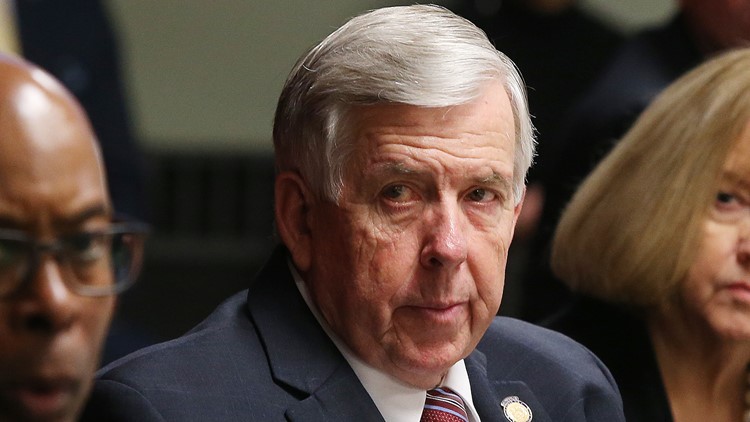JEFFERSON CITY, Mo. – Missouri Governor Mike Parson is not interested in pursuing the controversial labor issue known as ‘Right to Work’ during the upcoming legislative session, a spokesman said on Thursday.
Communications director Steele Shippy told 5 On Your Side the governor is more focused on pursuing other statewide issues like workforce development and infrastructure.
“As he’s said since the day after the election, the voters have spoken,” Shippy said.
Shippy also defended a months-long effort within the governor’s office to explore the possible implementation of Right to Work legislation in Missouri at the municipal level.
“It was just a research project,” he said.
On Wednesday, the 5 On Your Side I-Team obtained nearly 80 pages of often-redacted documents from the governor’s office through a public records request.
They detail an extensive policy and political initiative led by Chief of Staff Aaron Willard that began in July, shortly after Parson was sworn into office.
Internal e-mails, charts and memos show Parson’s staff were actively looking for options to potentially sidestep the anticipated loss of Right to Work during the August election.
For example, on August 6, just one day before the primary, Governor Parson’s policy director, Kayla Hahn, sent an e-mail to Willard. In it, she predicated Right to Work would be rejected by voters.
“According to the Secretary of State’s office, Missouri voters have rejected politicians’ laws in more than 90% of the referendum votes in the state’s history, and the historical odds are against the measure (Proposition A) being approved.”
"Missouri legislation rarely survives voter referendums,” she went on to write.
However, the memo’s very title already proposed a solution: “Right to Work by County Ordinance.”
Hahn goes on to discuss how municipalities in other states such as Illinois, New Mexico, Delaware and Kentucky, have passed the law locally, including details of the legal battles that followed.
To date, 27 states have Right to Work on the books.
She also provided links to “model ordinances” and “model language” for public and private sectors that have been developed by the American Legislative Exchange Council, an organization sponsored by the Koch Brothers.
Specifically, Hahn notes a correlation between a city or county that passed a local Right to Work ordinance and support for President Trump, among other factors including “favorable county government structures when considering partisanship…”
Another e-mail from July shows Willard requesting that a staff member research and report how Kentucky counties managed to enact Right to Work before it finally passed there at the state level.
On July 31, that staff member writes “We may consider drumming up a municipality in Missouri to pass a right-to-work ordinance.”
The same e-mail came with an offer from an attorney for the Illinois Policy Institute who might potentially take a pro-bono case for a municipality in Missouri.
Other e-mails obtained by the I-Team show Parson staffers assembling a chart to determine which Missouri counties would be the best test case. And one indicator was whether Donald Trump won the county in the November 2016 election.
According to public records, Parson’s executive team has identified 14 Republican stronghold counties that they believe would be “good candidates” for Right to Work at the county level.
They are: Atchison, Barry, Barton, Camden, Cape Giradeau, Dunklin, Howell, Jasper, McDonald, Newton, Pemiscot, Putnam, Stone and Taney.
But conversely, the governor’s team has also identified seven, more Democrat-leaning counties as “poor candidates” based on their “below average” support of President Trump.
They are: Boone, Clay, Jackson, Kansas City, Platte, St. Louis County and St. Louis City.
Shippy denied the work product was any attempt to go against the will of Missouri voters.
In August, Proposition A was overwhelmingly defeated in Missouri by 35 points, effectively killing the 2017 law that banned private employers from requiring workers to pay mandatory union dues.
For decades, opponents of Right to Work have contended that it leads to lower wages and fewer rights for workers. But supporters say Right to Work is better for the economy because it attracts more business and jobs.
Shippy said the governor’s office was just preparing for the August election, not knowing what the outcome would be.
He said once the results became clear, the governor’s team backed off their research efforts.
However, documents obtained by 5 On Your Side show Parson staffers were still communicating and looking at local Right to Work ordinances in September, well after the election.
Shippy said they were merely completing the project, which doesn’t mean it’s moving forward.
“The governor has no interest in putting Right to Work back on the table,” he said.
Meantime, a prominent St. Louis Democrat hopes that’s true.
“The governor, I don’t know if he’s carrying the water for the special interest groups, but it’s not what the people wanted,” said State Senator Jamilah Nasheed.
Nasheed said the primary results speak for themselves and should send a message to Jefferson City that Right to Work, even at the local level, would circumvent the will of voters.
“I don’t think that will work. I don’t think it can. I think it would be in the courts immediately,” she said.
Those same sentiments were shared by other elected officials, union leaders and viewers who reached out to 5 On Your Side Thursday.



